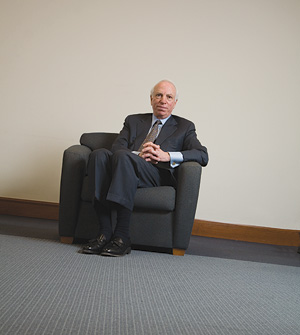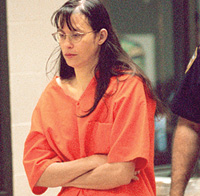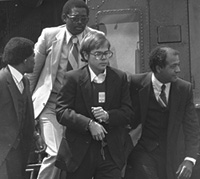Richard Bonnie ’69 Leads Insanity Defense Beyond Partisanship
 Richard Bonnie '69 |
Cullen Couch
One of the odd things about the insanity defense is that it is talked about far more than it is used. So rarely asserted, and so rarely successful, the outcry surrounding the insanity defense must be rooted in issues beyond law and policy. A single case can unleash a storm, especially if it occurs during a period of social unease such as the nation was enduring in the 1970s and early 1980s. Violent crime filled front page news. Critics were assailing the Warren Court’s jurisprudence on criminal law. Victim’s rights movements sought to restore the death penalty, abolish the exclusionary rule, and gut Miranda. The Dirty Harry blockbusters reflected the public temper.
 Andrea P. Yates is escorted from the court after being arraigned in Houston, June 22, 2001. Potential jurors in the retrial of Yates, who claims madness in the bathtub drownings of her five young children, challenged the legal definition of insanity in court June 22, 2006. As in her first trial, Yates pleaded innocent by reason of insanity in the drowning deaths of her children. Her earlier conviction was thrown out because of erroneous testimony. (AP Photo/Steve Ueckert, Pool)  John W. Hinckley, Jr. is shown in chains at the Quantico Marine Base, August 18, 1981, after arriving by helicopter from the Federal Correctional Institution in Butner, N.C. Hinckley had been undergoing psychiatric tests since his arrest. The label on Hinckley’s chest identifies a bulletproof vest he is wearing. (AP Photo/Bob Daugherty) |
The antecedents to the modern insanity defense emerged in the 16th century. Common law judges had long exempted children from criminal punishment based on a sliding scale of responsibility from infancy (none) through adolescence (presumed but rebuttable) and into adulthood (full). Out of that concept, rooted in the mens rea component of criminal law, arose the insanity defense. A couple of important cases refined it in the 18th century before yielding its “modern” form in the 19th century with the M’Naghten rule (as a result of mental disease, were defendants able to know the nature and quality of their conduct or, if they did know it, did they know it was wrong?).
In the mid-20th century, the drafters of the American
Law Institute’s influential Model Penal Code recommended
broadening the defense to include a “lack of volition”
component (a modernized version of the common-law
“irresistible impulse” defense), hoping to make the law
more receptive to advances in psychiatric medicine.
“The Model Penal Code approach wasn’t a radical
departure from the way the common law judges had
thought about responsibility,” says Richard Bonnie, the
Law School’s John S. Battle Professor of Law and director, University of Virginia Institute of Law, Psychiatry and
Public Policy, “but it signaled a greater willingness to
predicate the law of insanity on advances in medical understanding and to invite and rely upon expert
testimony about it.”
IN THE EARLY 1970s, Bonnie was associate director of the National Commission on Marihuana and Drug Abuse. Working with psychiatrists on the commission, he became interested in issues surrounding treatment for addiction, confidentiality, and the use of coercion. The work drew him into mental health law, a newly emerging field. When he returned to the Law School in 1973, he joined a nascent project in law and psychiatry led by Browning Hoffman, a psychiatrist who had joined the faculties of law and medicine in 1971. It was a natural extension of his interests.
Bonnie’s research in mental health law dovetailed with an early interest in the death penalty where it often comes into play. He became actively involved after the United States Supreme Court upheld its constitutionality in 1976. In fact, Bonnie represented the first four people sentenced to death in Virginia in post-conviction litigation, most of which involved psychiatric issues. Those efforts led him to ongoing research and law reform efforts on the connections between mental disorder and the death penalty.
Bonnie and Hoffman established a unique interdisciplinary program at UVA, establishing fellowships for lawyers, psychologists and psychiatrists, conducting research and working with policymakers in Virginia to protect patients’ rights and improve the quality of mental health testimony in criminal cases. The programs developed in Virginia became models for other states. “This was a period of intellectual excitement and policy innovation in the field of law and psychiatry,” Bonnie recalls, and “we were at the forefront of it here at Virginia.”
Bonnie and Hoffman were also working closely with leading figures in American psychiatry and in the bar to address such problems as psychiatric hospitalization of minors, rights of hospitalized patients, predictions about whether a person will be dangerous in the future, and improving expert testimony in criminal cases. They accomplished much of this under the auspices of the American Psychiatric Association, for whom Bonnie still serves as an advisor. In 1981, the American Bar Association launched a major project funded by the MacArthur Foundation, with Bonnie as a key architect, to develop standards for mental health issues in the criminal justice system. It was quiet, scholarly research, performed methodically and carefully. After Hoffman died in 1979, Bonnie continued the work.
Suddenly, politics and criminal law clashed in the wake of a presidential assassination attempt. In 1982, a jury found John Hinckley “not guilty by reason of insanity” for his shooting of President Reagan. The decision outraged the public and seemed to validate all the dire warnings in the preceding years about the erosion of law and order. The resulting glare of klieg lights, thunderous Senate hearings, and intemperate claims threatened to sweep aside the ancient precedents supporting the defense of insanity. As one of the country’s leading legal scholars on the issue, Bonnie was in the center of the storm.
He knew what was coming next.
“All the editorial commentary immediately after the acquittal said ‘abolish, abolish, abolish,’” recalls Bonnie. The Reagan administration introduced a bill to abolish the federal insanity defense. Many state legislatures followed suit. “There was no doubt what was happening,” says Bonnie. “The debate formulated at that time was simply ‘yes or no’ to the insanity defense.” The American Psychiatric Association, concerned about the repercussions of the verdict, appointed a special working group to take a position on the insanity defense. Meanwhile, the ABA project which Bonnie had been leading accelerated its consideration on the insanity defense.
Having explored the intellectual foundation of the insanity defense for many years, and studied its use in practice through evaluations conducted at the Institute’s Forensic Psychiatry Clinic, Bonnie had come to the conclusion that the volitional component of the MPC (the old “irresistible impulse” defense) did more harm than good. It created the classic “battle of the experts” that served only to distract a judge and jury from the more objective elements of a defendant’s mental state.
“One of the experts says, ‘yes, I think he had the ability to control his conduct’ and another one says, ‘no, he didn’t,’” says Bonnie. “Neither of them has any way of measuring volitional capacity. It is total guesswork. If we’re really interested in avoiding morally inappropriate punishment of severely mentally ill people, we don’t need the volitional formula. The appreciation-of-wrongfulness formula alone does a perfectly good job of avoiding unfair punishment.”
Bonnie advocated a modified approach that retained the co-called “cognitive” aspect of the MPC definition (whether the defendant “was unable to appreciate the wrongfulness of his conduct”) but removed its volitional component. Bonnie emphasizes that this is a position that he advocated before the Hinckley verdict, and that he does not believe that the verdict would have been different if the federal defense had been narrower at the time of his trial. However, in the political climate of the day, it was the MPC test (used in the federal courts and about half of the states) that had attracted the post-Hinckley ire of pundits, legislators, and the public. The idea was to offer a middle ground between abolishing the defense and keeping it as it is. Bonnie’s view offered a compromise solution, intellectually sound and grounded in years of study.
Within the space of a few months in the winter of 1982–83, both the APA and the ABA adopted his approach. “I suspect that it was the first time in history that these two organizations had basically taken an identical position,” says Bonnie. With the support of the psychiatric community and the national bar, Bonnie’s position took on a credibility and momentum. “I think it is historically accurate to say that the availability of the position I was advocating provided an alternative for legislators who supported the insanity defense but wanted to narrow it in some way.”Bonnie found that most people recognized that the insanity defense serves an important function. “It would be morally obtuse to convict people who are completely out of touch with reality at the time of their offense.” He would use as an example the case of a Virginia woman, clearly insane, who shot her aunt thinking she was possessed by the devil. He would ask, ‘Why would you convict somebody like that?’ “People understood that and recognized that the law can limit the defense to just those kinds of cases.”
Bonnie faced formidable opposition outside of the professional groups. The forces supporting abolition of the insanity defense fell into three camps: the tough-on-crime political conservatives who also favored abolishing the exclusionary rule; the intellectual critics led by Norval Morris of the University of Chicago Law School who derided the defense as a meaningless refinement of mens rea; and those in the medical community who felt the “battle of the experts” demeaned their profession. This third camp was represented most notably by the American Medical Association, which had officially adopted the abolitionist position even before the Hinckley verdict. Bonnie dismissed the AMA’s position as “not particularly credible” in comparison to the psychiatrists and psychologists who strongly supported the defense. He feels that the AMA had little understanding of the issue and an even smaller effect on the argument.
The opposition faded in the face of the moderate positions promoted by Bonnie and endorsed by the ABA and the APA. In public forums, Bonnie applauded the wisdom of state legislatures and legislators for resisting periodic efforts to abolish the insanity defense. He preached moderation, asking that they not react precipitously or they may do the wrong thing. “In thinking about it over a period of time, most legislators could recognize that the insanity defense has ancient roots, that it served an important moral function, and that it would be an overreaction to abolish it,” says Bonnie. Finally, the abolition movement faded in the state legislatures, and the Reagan administration withdrew its abolition bill. Congress adopted the compromise position in the Insanity Defense Reform Act of 1984.
The intense scrutiny that Hinckley brought to bear on the insanity defense likely ensured that the battle-hardened Bonnie version that emerged will be the last word on the subject. Certainly, another Hinckley might come along that sends the nation into a similar fever, but Bonnie doubts it. “It might be historically shortsighted, and there will always be these cases that will come up that will drive some movement to abolish, but I think it may have been historically settled with the Hinckley case.” He finds supportive evidence for this view in the public reaction to the two trials of Andrea Yates — strongly critical of the first verdict, which convicted her, and supportive of the second, which found her not guilty by reason of insanity. “This poor woman was severely psychotic when she drowned her five children to protect them from eternal damnation. There was no battle of the experts on the facts,” he points out. “The disagreement was about the meaning of the law of insanity, and, in the end, about the moral integrity of the criminal law.”




